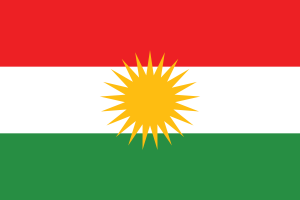Language/Central-kurdish/Vocabulary/Numbers-1-10
| ◀️ Possessive Pronouns — Previous Lesson | Next Lesson — Ordinal Numbers ▶️ |
Introduction[edit | edit source]
In this lesson, we will explore the numbers 1 to 10 in Central Kurdish. Numbers are an essential part of any language, and learning them will enable you to count, express quantities, and engage in basic numerical conversations with Kurdish speakers. Understanding how to count in Central Kurdish will also help you in various daily situations, such as shopping, telling time, and discussing ages. By the end of this lesson, you will be able to confidently count from one to ten and apply your knowledge in practical contexts.
Numbers 1-10[edit | edit source]
Let's start by learning the numbers from 1 to 10 in Central Kurdish. Pay close attention to the pronunciation and practice saying each number aloud.
Central Kurdish Numbers Table[edit | edit source]
| Central Kurdish | Pronunciation | English Translation |
|---|---|---|
| یەک | yēk | One |
| دوو | dō | Two |
| سێ | sē | Three |
| چوار | čwār | Four |
| پێنج | pēnch | Five |
| شەش | shesh | Six |
| حەوت | hēwt | Seven |
| هەشت | hesht | Eight |
| نۆ | nō | Nine |
| دە | dā | Ten |
Now, let's break down each number and learn how to pronounce them correctly.
1. یەک (yēk) - One
- The number یەک represents the quantity or value of one in Central Kurdish. It is pronounced as "yēk."
2. دوو (dō) - Two
- The number دوو represents the quantity or value of two in Central Kurdish. It is pronounced as "dō."
3. سێ (sē) - Three
- The number سێ represents the quantity or value of three in Central Kurdish. It is pronounced as "sē."
4. چوار (čwār) - Four
- The number چوار represents the quantity or value of four in Central Kurdish. It is pronounced as "čwār."
5. پێنج (pēnch) - Five
- The number پێنج represents the quantity or value of five in Central Kurdish. It is pronounced as "pēnch."
6. شەش (shesh) - Six
- The number شەش represents the quantity or value of six in Central Kurdish. It is pronounced as "shesh."
7. حەوت (hēwt) - Seven
- The number حەوت represents the quantity or value of seven in Central Kurdish. It is pronounced as "hēwt."
8. هەشت (hesht) - Eight
- The number هەشت represents the quantity or value of eight in Central Kurdish. It is pronounced as "hesht."
9. نۆ (nō) - Nine
- The number نۆ represents the quantity or value of nine in Central Kurdish. It is pronounced as "nō."
10. دە (dā) - Ten
- The number دە represents the quantity or value of ten in Central Kurdish. It is pronounced as "dā."
Now that you have learned the numbers 1 to 10 in Central Kurdish, practice saying them aloud several times to familiarize yourself with their pronunciation.
Cultural Insights[edit | edit source]
Understanding numbers in Central Kurdish not only helps with language skills but also provides insights into the cultural context. In Kurdish culture, numbers are used in various traditional practices, including wedding ceremonies, festive celebrations, and even storytelling. For example, certain numbers are considered lucky or have symbolic meanings. The number seven (حەوت) is often associated with good luck and is believed to bring blessings and prosperity. Similarly, the number three (سێ) is considered a sacred number and holds spiritual significance in Kurdish folklore.
Historically, the Kurdish region has been influenced by different civilizations and empires, resulting in variations in number systems. In some regions, particularly those that were part of the Ottoman Empire, you may come across alternative number systems rooted in Arabic or Turkish influences. However, the numbers covered in this lesson represent the most widely used and standardized Central Kurdish number system.
Practice Exercises[edit | edit source]
Now, let's practice what you have learned so far. Complete the following exercises to reinforce your understanding of Central Kurdish numbers 1 to 10.
Exercise 1: Matching Match the Central Kurdish numbers with their English translations.
1. یەک 2. دوو 3. سێ 4. چوار 5. پێنج 6. شەش 7. حەوت 8. هەشت 9. نۆ 10. دە
a. One b. Two c. Three d. Four e. Five f. Six g. Seven h. Eight i. Nine j. Ten
Solution: 1. a 2. b 3. c 4. d 5. e 6. f 7. g 8. h 9. i 10. j
Exercise 2: Fill in the Blanks Fill in the blanks with the correct Central Kurdish numbers.
1. Central Kurdish: سێ 2. Central Kurdish: دوو 3. Central Kurdish: چوار 4. Central Kurdish: نۆ 5. Central Kurdish: پێنج 6. Central Kurdish: یەک
Solution: 1. Central Kurdish: سێ 2. Central Kurdish: دوو 3. Central Kurdish: چوار 4. Central Kurdish: نۆ 5. Central Kurdish: پێنج 6. Central Kurdish: یەک
Conclusion[edit | edit source]
Congratulations! You have successfully learned the numbers 1 to 10 in Central Kurdish. This knowledge will allow you to count, express quantities, and engage in basic numerical conversations with Kurdish speakers. Remember to practice these numbers regularly to reinforce your understanding and improve your pronunciation. In the next lesson, we will explore ordinal numbers in Central Kurdish, which will further enhance your ability to express order and sequence. Keep up the great work!
Other Lessons[edit | edit source]
- Count to 10
- Health
- Family
- How to say Good Bye?
- Food
- Polite Expressions
- Days of the Week
- Ordinal Numbers
- Clothes
- Geography
Template:Central-kurdish-Page-Bottom
| ◀️ Possessive Pronouns — Previous Lesson | Next Lesson — Ordinal Numbers ▶️ |

